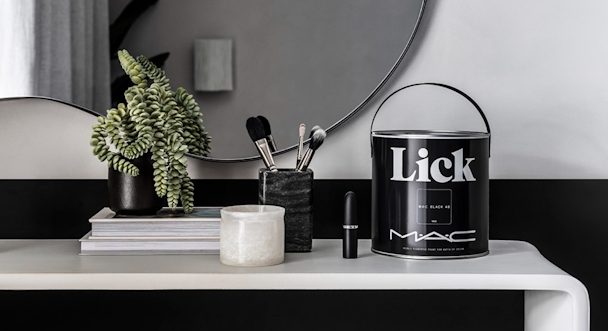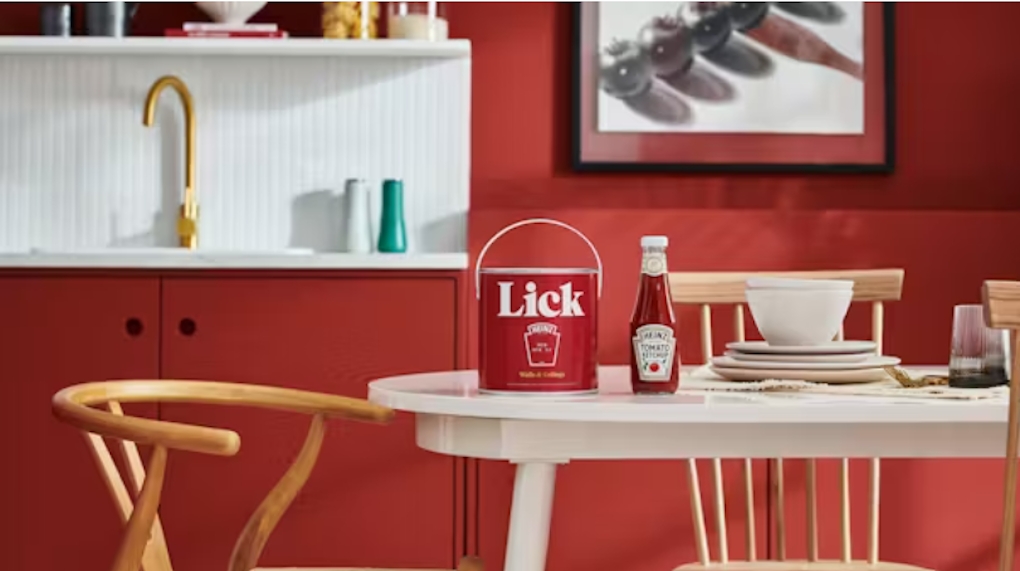How Lick ensures its marketing is more than just painting by numbers
The challenger brand has been freshening up the sector with influencer marketing, cool brand collabs and innovative comms.

Partnerships with the likes of Mac key to strategy / Mac x Lick
UK paint brand Lick was launched in 2020 by entrepreneurs Lucas London and Sam Bradley after the pair spotted a gap in the market for a cooler, more interesting paint company.
London and Bradley’s initial pitch to market was for Lick to be a direct-to-consumer e-commerce paint company that focused heavily on helping people make the right color choices for their houses beyond just a simple color swatch patch. For context, at launch, just 5% of paint was bought online.
Want to go deeper? Ask The Drum
“We didn’t believe there was a brand that was meeting the demands of the modern consumer, catering for them on color support, sustainability, quality or distinctiveness,” London tells The Drum.
After launch, Lick quickly gained the attention of younger decorators who discovered the brand through their Instagram feeds. Soon, Lick became the ‘it’ paint. Its popularity has been recognized by investors, who have helped the business raise over $38m in the past four years.
The UK paint market was dominated by the likes of Dulux, Crown and Farrow & Ball and most paint brought either in trade or at big DIY retailers, such as B&Q or Homebase. These days, though, the paint category has diversified and there are now other challengers, such as Coat and Yes Colours. London says this competition doesn’t concern him. “It’s really good to be aware of what other brands are doing. It keeps you on your toes and keeps you focused on innovating. But in truth, we start our day not thinking about any other brand but Lick.”
Advertisement
1. Inspiration and education
The big idea behind the Lick brand is to help people select the right color to paint their walls. London says the market lacks this. “There was nowhere in the mass market where you were getting any color support and there was a disjointedness between the inspiration phase that started online through to purchasing paint.”
This is at the core of Lick’s marketing and product strategy, guiding everything from social media ads to educational content, UX design and customer service. Lick was the first to develop a temporary stick-on color swatch, removing the need for people to paint swatches directly on to their walls: just one example of how it wants to be known for color inspiration.
“It’s everything from how to use color, how to create a mood or a style that you want, or how to create the best impact from a room that might be small or large or north facing or south facing,” London adds.
2. Capitalizing on Covid trends
Lick benefited from launching in March 2020, when people were forced to stay home and turned to DIY projects to entertain themselves. Initially launched as a direct-to-consumer product, Lick had an advantage over its mass-market competitors during this time as it was already set up to cater to online shopping.
In its marketing, Lick leaned into the psychology of color to make the case for redecorating to make people feel happier, relaxed and calm in their homes where they were spending all their time.
Post-Covid, however, the paint and DIY market has been going through a challenging time. London shares that since lots of people decorated during the lockdown and now there is a cost of living crisis, people’s budgets for home renovation have been squeezed and fewer people are buying homes. London says while the “act of decorating has reduced,” people’s interest in their homes has never been greater. Social media is full of home renovation and interior accounts, which London says demonstrates the appetite.
Advertisement
3. Partnerships

Lick has made a splash by partnering with iconic brands Heinz, Soho House and, more recently, the makeup label Mac. In each case, Lick produced new paint colors to match the palette of the brand, which London says is a “unique” offering in the partnerships space. These included a limited-edition ketchup color paint and an exclusive collection inspired by the color scheme in Soho House.
Campaigns such as these are a “powerful” way to share audiences and build brand awareness, London says. There aren’t plans to do lots of these collaborations, but rather one or two a year that have a better chance of giving the “surprise and delight” factor.
“It is vital with those campaigns that they are never gimmicky,” London says. “In each case, it’s a beautiful color that can be used uniquely and effectively around the house, rather than creating a color that no one wants to put on their walls.” The collaborations also have to go deeper than just the color and the PR around it; they must have a thorough content plan around them to show people how to use the color in their homes.
These campaigns aren’t just driving awareness of the brand but also boosting sales; Lick saw a 340% uplift in the sales of black paint after its Mac collaboration.
4. Micro influencers
When Lick first launched and marketing budgets were tight, London and Bradley asked their friends and family to repaint their homes and create content for social. Some of these posts garnered high levels of engagement, telling the pair that smaller social accounts with loyal followings could do more to grow the Lick brand. “That spurred us working with micro-influencers that were unique in the fact that they had a small but very engaged community of other decorators who were passionate about the home,” says London.
Content creators share Lick through their pages but also then give Lick the rights to imagery for it to publish on its owned channels. To this day, all images from Lick’s social accounts are taken by influencers rather than shot in a studio. “From day one, we wanted to create a visual look and feel that made people the creative content that resonated with people in homes that they could relate to,” London says. “So, while it was important to create imagery that inspires people, we thought it would be really effective to showcase real homes.”
Suggested newsletters for you
5. Paid social
At first, Lick’s marketing was primarily all social, including direct response ads on Meta and Google, but as Lick has grown and gone into third-party retail, marketing has moved up the funnel. “The best ROI for us is to drive mass brand awareness on key messaging and drive more eyeballs on our activity versus pure response,” London says. Meta and Instagram are still a big focus, but YouTube, Pinterest and now TikTok are key brand builders. “We’re excited by the younger demographic on TikTok, and as they mature and start to buy paint, they choose Lick.”
